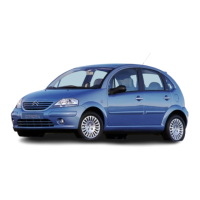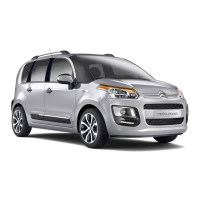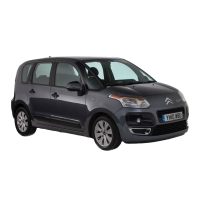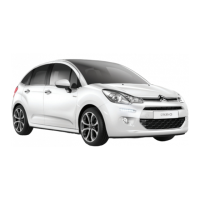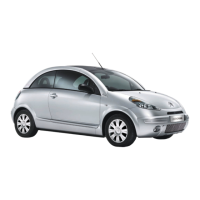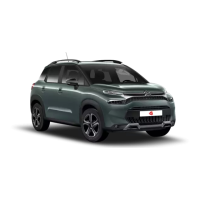Do you have a question about the CITROEN C3 2022 and is the answer not in the manual?
Description of vehicle controls and their locations within the cabin.
Explanation of the speedometer, rev counter, fuel gauge, and coolant temperature gauge.
Description of information shown on the vehicle's display screen.
General information on how warning and indicator lamps inform the driver about vehicle status.
Details on red warning/indicator lamps, including STOP and specific fault indicators.
Describes warning lamps related to brake fluid level and EBFD system faults.
Information on system activation, faults, and deactivation related to collision avoidance.
Warning lamp for ABS faults and advice on driving with conventional braking.
Warning for low tyre pressure, including audible signals and messages, and reinitialisation procedure.
Explains flashing warning for engine management faults and risk to catalytic converter.
Details on warning lamps for foot on brake and clutch pedal status.
Explanation of coolant temperature indicator zones and service indicator function.
Visual indicators and actions required for low AdBlue® levels and system malfunctions.
Information on detected malfunctions in the SCR system and potential starting prevention.
Overview of functions accessible via the 5-inch touch screen.
Details on accessing vehicle functions, audio, telephone, and alerts via the 7-inch touch screen.
Functions of the remote control and the built-in key for vehicle access and operation.
How the system allows unlocking, locking, and starting the vehicle with the electronic key.
Detailed steps for unlocking the vehicle with the electronic key and tailgating.
Procedures for normal locking, deadlocking, and advice on keyless entry.
Procedures for lost keys, remote control, electronic key, and central locking malfunctions.
Instructions for changing the battery in the remote control.
Operation of manual and automatic electric windows, including anti-pinch function.
Steps for adjusting seating, steering wheel, and mirrors for an ergonomic driving position.
Safety precautions and procedures for adjusting front seats, including longitudinal and backrest adjustments.
Explanation of air intake modes and how air circulates in the cabin.
Details on air vent controls and how to adjust air flow for windscreen, footwells, and side vents.
Operation of heating and manual air conditioning systems.
How to operate the air conditioning system for cooling and demisting.
Operation of the lighting stalk for main lighting, rear foglamp, and front/rear foglamps.
Operation of the wiper control stalk for windscreen wipers and wash.
Essential safety advice, including label warnings, using qualified workshops, and installing accessories.
Information on the eCall (SOS) system for emergency and assistance calls.
Overview of ESC systems including ABS, EBFD, EBA, ASR, and DSC.
Explanation of inertia reels, pyrotechnic pretensioning, and force limiting systems for seat belts.
General information on airbag systems, deployment, and safety recommendations.
How front airbags protect occupants in frontal impacts and adaptive inflation.
How lateral airbags protect occupants in side impacts.
How curtain airbags protect occupants in side impacts, and safety advice.
General recommendations and country-specific regulations for carrying children safely.
How to activate and deactivate the front passenger airbag using the glove box switch.
Description of ISOFIX anchor points and TOP TETHER for child seat installation.
Table detailing compatible child seat installations by seat position and type.
Procedures for starting and stopping the engine using the keyless system.
How the Stop & Start system functions, conditions for operation, and deactivation.
How the system detects low tyre pressure, including alerts and reinitialisation.
How the system detects and displays speed limits, with recommendations for use.
Controls for speed limiter and cruise control on the steering wheel.
How the speed limiter system works and its minimum speed setting.
How the cruise control system maintains vehicle speed and its operating requirements.
Overview of systems that warn of collision risks and assist with braking.
How the Collision Risk Alert function warns of potential collisions and how to modify trigger thresholds.
How iEBA increases vehicle deceleration when the driver brakes insufficiently.
How the automatic emergency braking intervenes and operates, including driver override.
How the system detects driver distraction and provides alerts.
How the system detects involuntary lane crossing and warns the driver.
How blind spot monitoring uses sensors and door mirror warnings to alert the driver.
How parking sensors detect and signal obstacles using audible and visual assistance.
Automatic activation and display of the reversing camera image, supplemented by parking sensors.
Information on compatible petrol and diesel fuels, including standards and additives.
Regular checks of essential fluid levels and advice on topping up.
How to check engine oil level using the dipstick or instrument panel, and recommended oil grade.
Details on AdBlue® level alerts, system operation, freezing, and refuelling precautions.
Information and procedures for dealing with vehicle breakdowns and emergencies.
Instructions for assembling and placing the warning triangle according to legislation.
How to use the temporary repair kit to fix a punctured tyre and adjust pressure.
Accessing and removing the spare wheel, including types and tool usage.
Procedure for starting the engine using another battery or charging a discharged battery.
Detailed steps for jump-starting a vehicle using another battery or booster.
General recommendations and constraints for towing the vehicle or another vehicle.
Information on engine characteristics, power, and fuel types.
Details on vehicle weights, towed loads, nose weight, and performance limitations.
Technical specifications for PureTech 110 S&S EAT6 and BVA6 engines.
Technical specifications for BlueHDi 100 S&S BVM6 Diesel engine, including towing.
Introduction to multimedia system functions, pairing, and safety.
Connecting a Bluetooth telephone, managing paired devices, and handling calls.
Introduction to GPS navigation, applications, audio system, and Bluetooth telephone functions.
How to use voice commands for navigation, radio, media, and telephone.
Specific voice commands for planning routes, finding POIs, and managing navigation.
Voice commands for making calls, managing contacts, and sending messages.
Detailed methods for entering destinations, searching for POIs, and calculating routes.
How to establish network connections for connected navigation services.
Information on how vehicle operating data is processed, stored, and used.
Connecting and using smartphone applications via the vehicle's system.
Description of vehicle controls and their locations within the cabin.
Explanation of the speedometer, rev counter, fuel gauge, and coolant temperature gauge.
Description of information shown on the vehicle's display screen.
General information on how warning and indicator lamps inform the driver about vehicle status.
Details on red warning/indicator lamps, including STOP and specific fault indicators.
Describes warning lamps related to brake fluid level and EBFD system faults.
Information on system activation, faults, and deactivation related to collision avoidance.
Warning lamp for ABS faults and advice on driving with conventional braking.
Warning for low tyre pressure, including audible signals and messages, and reinitialisation procedure.
Explains flashing warning for engine management faults and risk to catalytic converter.
Details on warning lamps for foot on brake and clutch pedal status.
Explanation of coolant temperature indicator zones and service indicator function.
Visual indicators and actions required for low AdBlue® levels and system malfunctions.
Information on detected malfunctions in the SCR system and potential starting prevention.
Overview of functions accessible via the 5-inch touch screen.
Details on accessing vehicle functions, audio, telephone, and alerts via the 7-inch touch screen.
Functions of the remote control and the built-in key for vehicle access and operation.
How the system allows unlocking, locking, and starting the vehicle with the electronic key.
Detailed steps for unlocking the vehicle with the electronic key and tailgating.
Procedures for normal locking, deadlocking, and advice on keyless entry.
Procedures for lost keys, remote control, electronic key, and central locking malfunctions.
Instructions for changing the battery in the remote control.
Operation of manual and automatic electric windows, including anti-pinch function.
Steps for adjusting seating, steering wheel, and mirrors for an ergonomic driving position.
Safety precautions and procedures for adjusting front seats, including longitudinal and backrest adjustments.
Explanation of air intake modes and how air circulates in the cabin.
Details on air vent controls and how to adjust air flow for windscreen, footwells, and side vents.
Operation of heating and manual air conditioning systems.
How to operate the air conditioning system for cooling and demisting.
Operation of the lighting stalk for main lighting, rear foglamp, and front/rear foglamps.
Operation of the wiper control stalk for windscreen wipers and wash.
Essential safety advice, including label warnings, using qualified workshops, and installing accessories.
Information on the eCall (SOS) system for emergency and assistance calls.
Overview of ESC systems including ABS, EBFD, EBA, ASR, and DSC.
Explanation of inertia reels, pyrotechnic pretensioning, and force limiting systems for seat belts.
General information on airbag systems, deployment, and safety recommendations.
How front airbags protect occupants in frontal impacts and adaptive inflation.
How lateral airbags protect occupants in side impacts.
How curtain airbags protect occupants in side impacts, and safety advice.
General recommendations and country-specific regulations for carrying children safely.
How to activate and deactivate the front passenger airbag using the glove box switch.
Description of ISOFIX anchor points and TOP TETHER for child seat installation.
Table detailing compatible child seat installations by seat position and type.
Procedures for starting and stopping the engine using the keyless system.
How the Stop & Start system functions, conditions for operation, and deactivation.
How the system detects low tyre pressure, including alerts and reinitialisation.
How the system detects and displays speed limits, with recommendations for use.
Controls for speed limiter and cruise control on the steering wheel.
How the speed limiter system works and its minimum speed setting.
How the cruise control system maintains vehicle speed and its operating requirements.
Overview of systems that warn of collision risks and assist with braking.
How the Collision Risk Alert function warns of potential collisions and how to modify trigger thresholds.
How iEBA increases vehicle deceleration when the driver brakes insufficiently.
How the automatic emergency braking intervenes and operates, including driver override.
How the system detects driver distraction and provides alerts.
How the system detects involuntary lane crossing and warns the driver.
How blind spot monitoring uses sensors and door mirror warnings to alert the driver.
How parking sensors detect and signal obstacles using audible and visual assistance.
Automatic activation and display of the reversing camera image, supplemented by parking sensors.
Information on compatible petrol and diesel fuels, including standards and additives.
Regular checks of essential fluid levels and advice on topping up.
How to check engine oil level using the dipstick or instrument panel, and recommended oil grade.
Details on AdBlue® level alerts, system operation, freezing, and refuelling precautions.
Information and procedures for dealing with vehicle breakdowns and emergencies.
Instructions for assembling and placing the warning triangle according to legislation.
How to use the temporary repair kit to fix a punctured tyre and adjust pressure.
Accessing and removing the spare wheel, including types and tool usage.
Procedure for starting the engine using another battery or charging a discharged battery.
Detailed steps for jump-starting a vehicle using another battery or booster.
General recommendations and constraints for towing the vehicle or another vehicle.
Information on engine characteristics, power, and fuel types.
Details on vehicle weights, towed loads, nose weight, and performance limitations.
Technical specifications for PureTech 110 S&S EAT6 and BVA6 engines.
Technical specifications for BlueHDi 100 S&S BVM6 Diesel engine, including towing.
Introduction to multimedia system functions, pairing, and safety.
Connecting a Bluetooth telephone, managing paired devices, and handling calls.
Introduction to GPS navigation, applications, audio system, and Bluetooth telephone functions.
How to use voice commands for navigation, radio, media, and telephone.
Specific voice commands for planning routes, finding POIs, and managing navigation.
Voice commands for making calls, managing contacts, and sending messages.
Detailed methods for entering destinations, searching for POIs, and calculating routes.
How to establish network connections for connected navigation services.
Information on how vehicle operating data is processed, stored, and used.
Connecting and using smartphone applications via the vehicle's system.
| Brand | CITROEN |
|---|---|
| Model | C3 2022 |
| Category | Automobile |
| Language | English |
